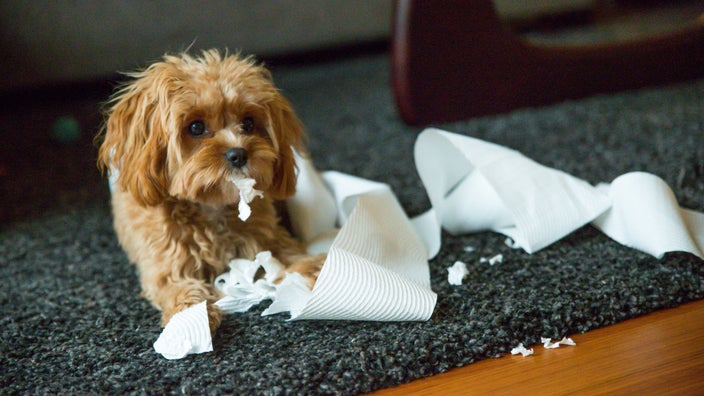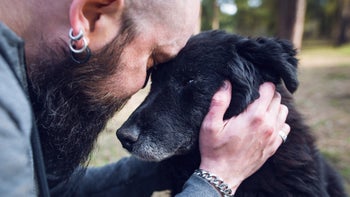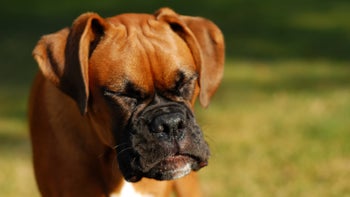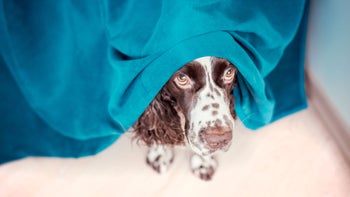
Pica in Dogs: The Condition That May Be Causing Your Dog to Eat Nonfood Items
Key takeaways:
Pica — most often seen in adolescent and adult dogs — is the compulsive urge to consume inedible items, such as rocks, dirt, cardboard, and clothing.
The cause of pica can be either medical or behavioral, and treatment varies based on the underlying cause.
This disorder can be life-threatening, especially when the ingested item is toxic or gets lodged in a dog’s intestinal tract and causes a blockage.
Table of contents

Dogs are curious creatures, especially puppies, who explore their surroundings with their mouths. But when your pet starts eating inedible items — such as rocks, dirt, toys, and cloth — it could be a sign of pica.
Pica is when a dog has the urge to eat inedible items. Pica can endanger your dog’s health by:
Causing them to eat something toxic
Hurting their teeth and gums
Disrupting their digestive system
Getting an object lodged in their intestinal tract
Save on the top 10 pet medications
Save big on common pet medications like Fluoxetine and Levetiracetam at your local pharmacy.

GoodRx is NOT insurance. GoodRx Health information and resources are reviewed by our editorial staff with medical and healthcare policy and pricing experience. See our editorial policy for more detail. We also provide access to services offered by GoodRx and our partners when we think these services might be useful to our visitors. We may receive compensation when a user decides to leverage these services, but making them available does not influence the medical content our editorial staff provides.
Could your dog have pica? Let’s take a closer look at this canine health condition.
Signs and symptoms of pica in dogs
The most obvious symptom of pica is that your dog regularly chews on or consumes nonfood items. Curious pups may gnaw on something once or twice. But with pica, your dog will continually seek out inedible things. Some dogs stick to eating only one inedible object, while others may go after a wide variety of items, from cloth or paper to drywall.
When your dog has pica, they can have additional symptoms caused by eating nonfood items. Items can get stuck in the throat, stomach, or intestines and lead to:
Drooling
Gagging
Safe vs. toxic foods: Can my dog eat what I eat? It depends. Some human foods are safe for dogs while others are poisonous.
Signs of dog pain: Dogs can’t tell you when they’re in pain. Changes in their behavior may offer clues.
Depression in dogs: Does your pup seem down in the dumps? Dogs get depressed just like people do.
What causes pica in dogs?
The cause of pica can either be behavioral or medical, said Amber Karwacki, DVM, a partner veterinarian with Heart + Paw in Philadelphia. Some of the more common causes include:
Boredom
Lack of exercise in high-energy breeds
Lack of chew toys
Parasite infection
Common causes for pica in older dogs include:
Intestinal tumor
Inflammatory bowel disease
Chronic kidney disease
When a dog is anemic, or cannot absorb nutrients in the food they are eating, they may experience a form of pica known as geophagia. Dogs with this condition consume soil, clay, and dirt. Even though the causes may be different in pica and geophagia, the symptoms are the same.
Eating poop, however, is a separate condition called coprophagia. “If your adult dog starts to eat their own feces, there could be a nutritional imbalance,” said Karwacki. She suggests an exam and lab work at the clinic to help determine the cause of the imbalance.
How do you test for pica in dogs?
Generally, pica can be diagnosed by the dog’s behavior alone. Your veterinarian will likely run blood tests to look for any other underlying medical conditions. They may also perform a thorough behavioral consult to determine if anxiety or boredom are driving your dog to consume nonfood items.
Read more like this
Explore these related articles, suggested for readers like you.
How do you treat pica in dogs?
Treatment for pica will depend on whether the cause is medical or behavioral. For a medical condition, Karwacki said your veterinarian will prescribe treatments to manage the condition.
For anxiety, your dog may need behavioral interventions, “along with possible anxiety medication,” said Karwacki. Consult with a behavioral veterinarian to develop an individualized plan.
If your dog’s pica is caused by another behavioral issue, you may need to use a number of strategies. For example, if your dog is bored or needs more activity, you can work to address these needs. At other times, training may be recommended.
Consider setting time aside every day to do some training exercises and games with your dog in the backyard, suggests Lauren Jay, a dog trainer in Queens, New York.
“Make your dog way more interested in interacting with you while burning off that extra mental energy that your stressed and/or bored dogs have bottled up that lead to pica,” said Jay. Additionally, pet parents can help their dogs by providing safe and sturdy chew toys and food puzzles.
If your dog starts eating rocks and dirt in the backyard, keep them on a leash, or block access to rocks using fencing. On walks, have treats or a toy ready to distract your pup and keep them from inedible items.
“A basket muzzle can also be used to physically prevent your dog from eating what they should not eat,” recommends Karwacki.
Do dogs grow out of pica?
Puppies tend to put everything in their mouths. That’s part of their normal behavior, and most grow out of the phase, said Karwacki. Older dogs who develop pica will likely need intervention.
Pet parents can help their pups from a young age by training and teaching them what is appropriate to chew. Carefully monitoring your dog during playtime or time outdoors can also help prevent them from eating nonfood items.
For dogs that don’t grow out of it, behavioral training early on can help change their behavior. For example, Jay recommends redirecting your dog’s attention onto you within 2 seconds of them seeing a desired item. Then, walk in the opposite direction.
“Give food as a reinforcement,” said Jay. “Teaching ‘leave it’ and ‘drop it’ prior to the stressful situation will also be very helpful.”
Frequently asked questions
Terriers, spaniels, and collies seem more likely to eat nonfood items than other breeds. It’s not clear why this is. But we do know that dogs with anxiety or who don’t have enough activity and enrichment are especially at risk.
Zinc and iron deficiencies have been linked to pica behavior in dogs. If this is why your dog is eating inappropriate items, your veterinarian will need to rule out a medical condition causing the vitamin deficiency. From there, your vet will provide guidance on addressing any potential nutritional issues.
The bottom line
Pica is a condition that may lead your dog to eat nonfood items, such as rocks or cloth. The condition can be caused by a medical issue, like not getting enough nutrients. Pica can also be caused by a behavioral issue, such as anxiety or boredom. If you notice your dog eating items they shouldn’t, it’s time for a vet visit to diagnose and treat pica. If left untreated, pica can be life-threatening if your dog consumes an object that causes a blockage or a substance that’s toxic.
Why trust our experts?



References [References]
Brister, J. (2018). Feces eating in dogs and cats. Veterinary Partner.
Eyarefe, O. D. (2016). Pica in dogs: Overview, owners perception and intestinal perforative obstructive cases in Ibadan, Nigeria. Global Veterinaria.
Gibeault, S. (2024). Pica in dogs: What to know. American Kennel Club.
Landsberg, G. M., et al. (2014). Behavioral problems of dogs. Merck Veterinary Manual.
Lotz, K. (2022). Why does my dog eat dirt? American Kennel Club.
Trott, T., et al. (n.d.). Unusual eating habits in dogs and cats. UC Davis Veterinary Medicine.
Van Goethem, B. (2015). Gastro-intestinal foreign bodies (do’s and don’ts). World Small Animal Veterinary Association World Congress Proceedings.





























